



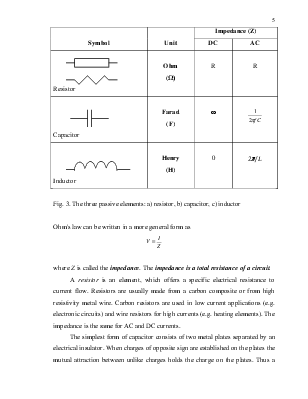
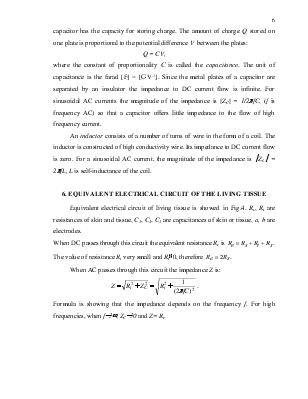
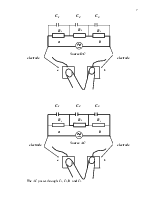
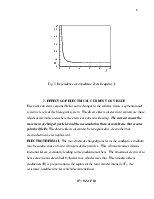
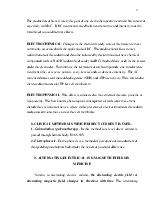
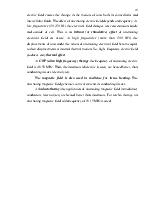
Lecture 5.
Electrical phenomenon in the organism
The biological tissue is composed of atoms containing positively charged nuclei and negatively charged electrons.
An atom is neutral. However when an outside force such as light, heat, electrostatic fields acts upon it and an atom can lose or gain electrons. These atoms, which are no longer in the neutral state, are either positive or negative. This process of changing the state of an atom is called ionization. A positive ion has lost one or more electrons and is referred to as a cation. A negative ion has gained one or more electrons and is referred to as an anion. A cation is attracted to the cathode and an anion is attracted to the anode.
So, the biological tissue and liquids contain ions (cations and anions) and the ions can be formed under the external forces.
2. Electric and magnetic fields
Each charge creates an electrical field around itself. Thus electrical charges must have an influence in the area surrounding them. Basic characteristic of electrical field is an intensity of electric field (E) that is force acted on unit positive charge placed at the certain point of the field.
Each moving charge creates a magnetic field around itself. Magnetic field is characterized by an induction of field (B). The value of induction determines the force acted on moving charge at the certain point of the magnetic field.
Whenever electrical charges of opposite sigh become separated an electrical field is created and a potential difference is established.
This separation of charge can occur for several reasons: temperature gradients or concentration gradients. If the charges exist on the surface of a material, the material is said to be polarized.
 |
|||
 |
|||
Fig. 1. The direction of the intensity of electric field (E) and the induction of magnetic field (B).



 |
 |
Fig. 2. The types of dielectric polarization.
E denotes an external electrical field, Epol denotes polarized field.
3. Conductors and insulators
Charged particles such as electrons in metals or ions in solution (electrolytes) will tend to move or change position due to their interaction with other charged particles. They will thus move when an electrical potential difference exists.
Conductors are substances in which charged particles readily move when placed in an electric field. Have only one or two valence electrons and tend to lose them (gold, cooper, silver).
Insulators are substances which do not tend to allow free movement of ions or electrons when placed in an electric field. Valence shells almost completely filled therefore do not tend to lose electrons (rubber, glass, fat).
The body contains a number of different tissues, which contain charged particles such as sodium, potassium and chloride, which are free to move in the presence of an electric field or potential difference. Blood, muscles and spinal cord liquid are good conductors.
Fat on the other hand acts as a good insulator because it has fewer free electrons that move when acted upon by an electrical field. Skin and bones are also good insulators.
4. DIRECT AND ALTERNATIng CURrENT
The movement of charged particles in a particular direction constitutes a current. In an electrical circuit the current is due to the flow of electrons (electronic current) whereas in living organisms it is due to the flow of ions (ionic current).
The direction of current flow, which is indicated by an arrow (with symbol I), shows the direction of movement of positive charges.
 |
The current I is defined as the amount of charge that passes through a circuit in one second:
 ,
,
where DQ is the amount of charge that flows during time Dt . The unit of current is the ampere [A=C×s-1].
The potential difference V creates an electric field of intensity E, which causes the charge carriers to move. With many electrical conductors the potential difference is directly proportional to the current:
V = IR or  (Ohm’s law)
(Ohm’s law)
The constant of proportionality R is called the electrical resistance and has units of ohm [W] = [V×A –1].The resistance of a conductor is proportional to its length L and inversely proportional to its cross-sectional area A
 ,
,
where r, the resistivity of material, has unit of [W×m].
The term potential difference and voltage are used synonymously.
There are two kinds of current, direct current (DC) in which the charges always flow in the same direction and alternating current (AC) in which the charge flows backwards and forwards.
Two types of element are used in electrical and electronic circuits: passive and active. Passive elements impede current flow whereas active elements generate a change in current flow. We consider three passive elements: resistors, capacitors and inductors.
|
Symbol |
Unit |
Impedance (Z) |
||||
|
DC |
AC |
|||||
|
Resistor |
Ohm (Ω) |
R |
R |
|||
|
Capacitor |
Farad (F) |
¥ |
|
|||
|
Inductor |
Henry (H) |
0 |
2pf L |
|||
Fig. 3. The three passive elements: a) resistor, b) capacitor, c) inductor
Ohm's law can be written in a more general form as

where Z is called the impedance. The impedance is a total resistance of a circuit.
Уважаемый посетитель!
Чтобы распечатать файл, скачайте его (в формате Word).
Ссылка на скачивание - внизу страницы.